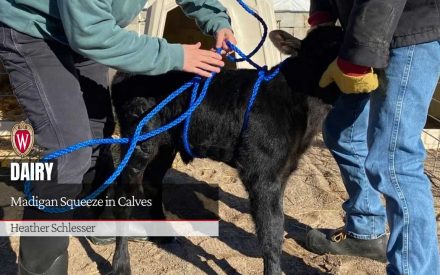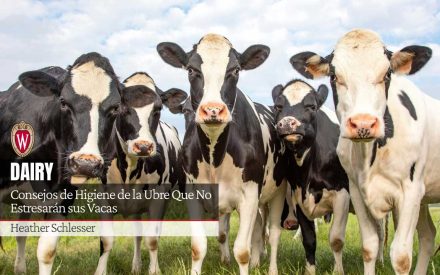Dairy cow housing facilities are a double-edged sword regarding hoof health and lameness. Built right and managed properly, housing facilities can limit the problem and aid recovery. According to Dr. Nigel Cook at the UW School of Veterinary Medicine, achieving and maintaining high-level dairy production are directly related to hoof health and lameness for every dairy farm.
This article focuses on hoof health and its relationship to dairy cow housing and facilities. Specific topics covered on the following pages:
- Stall Dimensions
- Stall Surface
- Alley Dimensions
- Stocking Rates
- Flooring
- Grooving
- Parlor Holding Area
- Ventilation
- Pasture Access
* Separate fact sheet available for footbaths.
While stall size and surface material play a big role, other features like alley width, flooring/grooving, holding areas, transfer lanes, ventilation and stocking rate all influence the rate and duration of lameness from poor hoof health.
Collectively, these housing factors all add up to cow comfort. Poor stall design and improper surfaces can reduce or extend laying time, adversely affecting normal cow behavior (12-13 hours of lying time per day). For example, rubber pen floors, improper stall design, and/or an uncomfortable stall surface negatively affect hoof health and lameness by increasing cow preference to stand or lay on the rubber floor and spending less time resting comfortably in her stall.
Wet, slippery, over-crowded alleys and pens can also increase lameness due to physical injury and reduced hoof health from more exposure to added waste and moisture. Poorly ventilated barns can also disrupt normal cow behavior, increasing standing time and lowering feed intake, two important factors associated with overall hoof health and lameness.
Parlor holding pens, bedded pack recovery areas, and pasture access are just a few other housing considerations that can significantly impact hoof health. Read on to keep your cows walking strong!
This and several other dairy management-related apps are available at the iTunes store, including an app to help assess lameness in your dairy herd with locomotion scoring using an iPad.
Stall Dimensions (refer to diagram and table)
Every piece of stall design is important for cow comfort. Each component works only if every other component is properly designed and installed. In general, it is recommended stalls be sized to provide for the largest 25 percent of cows in the group. Compromises may need to be made if the group consists of greater than 50 percent first lactation heifers. Typical lunge space for a mature Holstein cow is an additional three to four feet beyond resting length, making total stall length against a sidewall around 10 feet (limit sidewall height to < 36”). In head-to-head stalls, a 17 to 18 feet platform is recommended (16 feet minimum).
Stall Surface
Sand is the ideal bedding surface, helping limit bacterial exposure while providing cushion and traction for the cow. A survey of 176 sand herds showed 7 lbs. more milk per cow per day (2,500+ lb. rolling herd average), lower SCC, less lameness, and lower turnover rates.
While studies have found a lower level of lameness in barns with deep bedded sand freestalls compared with mattress or mat-bedded stalls, there is also an advantage for the lame cow in a deep sand bedded stall by encouraging a more normal resting behavior, or the “Goldilocks” effect…not too short, not too long, especially for older cows.
Mattress herds that can achieve low rates of lameness usually have these key management practices to help avoid lameness and maintain good hoof health:
- Early and active surveillance. At least once each week, observe cows moving to the parlor at a specific point and grade them with a locomotion score (see UW Vet School app).
- Move lame cows to a dedicated pack area near parlor, not a sick pen, but an area where cows can recover from sore feet and still produce saleable milk.
- Prevention is essential with timely hoof trimming from a qualified hoof care specialist. Trim heifers at transition; cows at dry-off and again 60-120 days in milk. Monitor all cows with prior hoof health issues every 90 days.
- Avoid overstocking, reduce lock-up time, and reduce the milking frequency of lame cows from 3x to 2x, giving them less time on their feet and more time to recover.
Alley Dimensions, Stocking Rates & Bunk Space - 1.2 cows per stall for milking pens
- 1.0 cows per stall for transition pens
- 24” bunk per cow for milking and breeding pens
- 30” bunk per cow for transition groups
Flooring
- Concrete should be at least 4” thick and grooved or textured. Clay and finer aggregates, washed free of impurities, are preferred. Stronger, more durable concrete is recommended to avoid wear and pitting, which leads to increased hoof wear. Use 4,000 psi concrete 6-bag mix for freestall pen alley floors and 5,000 psi 8-bag concrete mix for transfer lanes and holding areas. Concrete must be mixed, poured, and grooved correctly to reduce the risk of slipping.
- Animals walking on rubber have been shown to slip less, with longer, fewer strides, increasing walking speed compared to concrete. For this reason, rubber flooring is common to facilitate cow movement between pens and the milking center, to help reduce new cases of lameness, and less pain when lame cows move.
- Although popular, evidence of a significant benefit from rubber flooring in freestall pens is lacking. The addition of rubber flooring to a pen with uncomfortable stalls is not recommended. Barn areas in order of importance for rubber flooring include 1) Transfer lanes, 2) Holding area, 3) Sloped parlor return lanes, and 4) Parlor.
- Consider rubber along the feed bunk only with optimal stall design. When choosing rubber, pay attention to its compressibility. Hard rubber belting tends to be firm, which leads to an increased risk of slipping on sloped floors. Products with more natural rubber tend to have greater compression, making it less slippery and better suited for holding areas and sloped return lanes.
Grooving Patterns
- The cow’s foot should contact the floor over a groove wherever it lands. This will force manure into the groove and facilitate contact between the claw sole and the concrete surface, stopping the claw from sliding. Side walls must be vertical rather than V-shaped. Level the surface of the concrete before using the float to create sharp smooth groove edges.
- V-shaped grooves are not recommended, as the hoof wall can slide into these, and the hoof can twist. Cobblestone floors are not recommended as the surface is often uneven between grooves, and the grooves become too shallow after a year or so of scraping.
- Consider a diamond pattern spaced 4 – 5” on center where cows must make sharp turns or in wet, slippery cross alleys with waterers.
- The flooring surface must be flat, not convex, between grooves. Edges must be smooth, with little or no aggregate exposure. A skilled operator should do floating and stamping promptly when the concrete is not too wet (grooves tend to fill in, concrete sticks to stamp), or too dry (poor penetration and shallow grooves with aggregate exposure and bulging between grooves).
- Before cows are exposed to the concrete, grind the floor to remove all sharp and broken edges.
- For existing floors worn smooth, or where aggregate is exposed, texturing is an excellent option vs. re-grooving. Different options: AGRI-TRAC (www.agritraction.com) or Trac Rite (www.trakriteusa.com).
Milking Parlor Holding Area
- 15 to 20 square feet per cow for the largest group (add 25 percent if the following group is brought in while the prior group is still milking.) Do not exceed 2 percent floor slope.
- Provide lengthwise grooving through the holding area (¾” wide, ½” deep, and 3 ¼” on center), or highly compressible rubber flooring in the holding area.
- Dual transfer lanes, each 15 feet wide, allow cows to move to the holding area while the previous group returns.
- The front holding area should narrow to 3.5 feet wide so that only one cow enters the parlor at a time. The entry lane should be 12 feet long for two cows to stand nose-to-tail. Avoid pockets or wide funnels where cows can stand crossways and block entry.
- Single file return lanes from each exit of a double-sided parlor must be 4 feet wide. Rotary parlor return lanes with a single exit point should be at least two cow-widths (8 to 10 feet wide).
- Return lanes should not be used for palpation rails; palpation rails should not be parallel to the return lane. Dual return lanes allow for bypassing the footbath when not in use.
- Cooling the holding area should be addressed before all other areas on the farm. Provide 1,000 CFM per cow air flow through recirculation fans activated at 65 degrees with soakers to wet the cow before entering the parlor.
Ventilation / Heat Abatement
- Not uncommon to see an increase in lameness two months after peak heat stress (usually September/October) due to increased standing time and risk of more rumen acidosis during hot summer months.
- Orientation of the barn will affect heat and light accumulation. An east-west orientation will result in reducing solar exposure. Ventilation is essential, with natural ventilation requiring a location free of wind barriers and open side walls greater than 12 feet with a pen ridge (2”/10 feet) and 4/1 minimum roof pitch.
Pasture Access
- Two recent studies show pasture access is a significant factor influencing lameness. Chapinal et al. (2013) showed in Northeast dairy herds, lameness decreased with deep bedding and pasture access during the dry period, and in a group of high-producing Wisconsin freestall herds, nine percent allowed the high group mature cows pasture access with a beneficial effect on lameness.
- For barns with comfort issues, such as uncomfortable mat or mattress stalls, allowing strategic periods outside the barn may positively impact lameness prevention and recovery. Caution with pasture lot access for early lactation groups since this may increase the risk for ketosis and potentially limit production.
Footbath Design /Management
Note…a separate fact sheet is available, which provides current recommendations from the UW Vet School for footbath design and management practices.

 Madigan Squeeze in Calves
Madigan Squeeze in Calves Consejos de Higiene de la Ubre Que No Estresarán sus Vacas
Consejos de Higiene de la Ubre Que No Estresarán sus Vacas ▶️ Watch: Generalidades de la podología bovina especializada
▶️ Watch: Generalidades de la podología bovina especializada Understanding Liver Flukes in Wisconsin cattle: Lifecycle, Risks, and Control Strategies
Understanding Liver Flukes in Wisconsin cattle: Lifecycle, Risks, and Control Strategies


